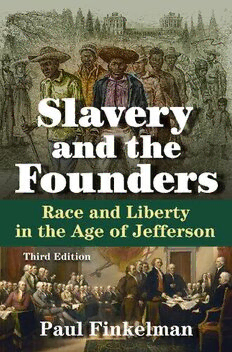
Slavery and the Founders: Race and Liberty in the Age of Jefferson PDF
Preview Slavery and the Founders: Race and Liberty in the Age of Jefferson
Slavery and the Founders This page intentionally left blank Slavery and the Founders Race and Liberty in the Age of Jefferson Third Edition Paul Finkelman Routledge Taylor & Francis Group LONDON AND NEW YORK First published 2014 by M.E. Sharpe Published 2015 by Routledge 2 Park Square, Milton Park, Abingdon, Oxon OX14 4RN 711 Third Avenue, New York, NY 10017, USA Routledge is an imprint of the Taylor & Francis Group, an informa busin ess Copyright © 2014 Taylor & Francis. All rights reserved. No part of this book may be reprinted or reproduced or utilised in any form or by any electronic, mechanical, or other means, now known or hereafter invented, including photocopying and recording, or in any information storage or retrieval system, without permission in writing from the publisher s. Notice s No responsibility is assumed by the publisher for any injury and/or damage to persons or property as a matter of products liability, negligence or otherwi se, or from any use of operation of any methods, products, instructions or ide as contained in the material herei n. Practitioners and researchers must always rely on their own experience a nd knowledge in evaluating and using any information, methods, compounds, or experiments described herein. In using such information or methods they shou ld be mindful of their own safety and the safety of others, including parties for whom they have a professional responsibilit y. Product or corporate names may be trademarks or registered trademarks, an d are used only for identification and explanation without intent to infring e. Library of Congress Cataloging-in-Publication Data Finkelman, Paul, 1949– author. Slavery and the founders : race and liberty in the age of Jefferson / by Paul Finkelman.— Third edition. pages cm Includes bibliographical references and index. ISBN 978-0-7656-4145-8 (hardcover : alk. paper)—ISBN 978-0-7656-4146-5 (pbk. : alk. paper) 1. Slavery—Law and legislation—United States—History. 2. Slavery—United States— History. I. Title. KF4545.S5F565 2014 306.3’62097309033—dc23 2013041317 ISBN 13: 9780765641465 (pbk ) ISBN 13: 9780765641458 (hbk ) For Abby and Isaac This page intentionally left blank Contents Preface to the Third Edition ix 1. Making a Covenant with Death: Slavery and the Constitutional Convention 3 2. Slavery and the Northwest Ordinance, 1787: A Study in Ambiguity 46 3. Evading the Ordinance: The Persistence of Bondage in Indiana and Illinois 74 4. Implementing the Proslavery Constitution: The Adoption of the Fugitive Slave Law of 1793 102 5. Ending the African Slave Trade in the New Nation 133 6. The Problem of Slavery in the Age of Federalism 163 7. “Treason Against the Hopes of the World”: Thomas Jefferson and Slavery 193 8. Thomas Jefferson, Sally Hemings, and Antislavery: Historians and Myths 237 Bibliography 281 Index 295 About the Author 309 This page intentionally left blank Preface to the Third Edition This book stems from my belief that slavery was a central issue of the American founding. My goal is to better understand how the first generation of leaders of the United States dealt with the profoundly important question of human bondage. Slavery was legal in all thirteen colonies when the American Revolution began. When the Constitution was written, slavery was still legal in all but two states (Massachusetts and New Hampshire), although three others (Penn- sylvania, Connecticut, and Rhode Island) were in the process of gradually abolishing the institution. By the time Thomas Jefferson began his second term as president, in 1805, New York and New Jersey had also taken steps to end slavery, and Vermont and Ohio had joined the Union as free states; but, Kentucky and Tennessee had also joined the Union as slave states. The na- tion was now half slave and half free, and would essentially remain so until the Civil War finally led to the end of slavery six decades later. This book explores the tension between the professed ideas of America, as stated in the Declaration of Independence, and the reality of early national America. Jefferson’s words from the Declaration ring true today. Americans continue to believe it is “self-evident” that we are all “created equal” and are “endowed” with the “unalienable Rights” of “Life, Liberty, and the Pursuit of Happiness.” American political debate today, just as in the 1780s and 1790s, often focuses on how government may best help all Americans achieve these goals. Despite Jefferson’s fine words and our belief in this credo, it is clear that liberty was not available to most African-Americans at the time of the found- ing. In Chapters 7 and 8 of this book, I argue that Jefferson— who owned more than 150 slaves when he wrote the Declaration—did not in fact believe that blacks were entitled to the same rights as other Americans. In other chapters, I suggest that attempts to limit or undermine slavery in this period were weak and often ineffectual. I argue that the denial of the “bless ings of liberty” to slaves profoundly affected the formation of the nation. Since I first wrote those chapters, other scholars have explored Jefferson’s personal relationships with ix
